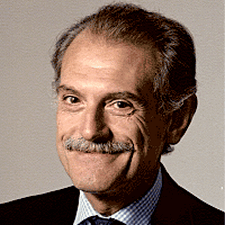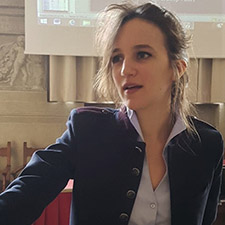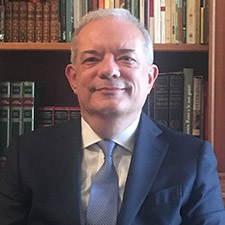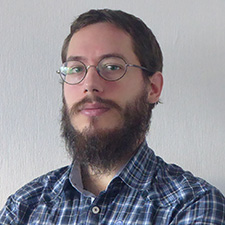Keynotes
Alberto Sangiovanni-Vincentelli
Department of Electrical Engineering and Computer Sciences, University of California at Berkeley

The good, the bad and the ugly of automation: looking back at the advent of Electronic Design Automation and its implications today
Abstract
Automation on one hand is touted as the pillar of Industry 4.0 and a fundamental enabler of autonomous vehicles. On the other, automation is considered a threat to employment. The truth may as always be in the middle. In the 1970s, the integrated circuit industry saw a rapid growth following the famous Moore's Law that predicted the doubling of number of transistors per square inch every year since their invention. However, the design complexity was growing at the same pace, if not more, and it was becoming a bottleneck. The only way to reduce the cost and time to bring new products to market was to develop algorithms and software systems to replace manual design at lower levels of abstraction. Electronic Design Automation since the late 1980s has become a fundamental enabler for the industry. Thousands of low level design jobs disappeared but the capabilities of engineers who conceived new architectures and devices were greatly enhanced. I will review this evolution and compare to today's rapid growth of robotics and AI.
Biography
Alberto Sangiovanni Vincentelli holds the Edgar L. and Harold H. Buttner Chair of Electrical Engineering and Computer Sciences at the University of California at Berkeley. He has been on the Faculty of the Department since 1976. He obtained an electrical engineering and computer science degree ("Dottore in Ingegneria") summa cum laude from the Politecnico di Milano, Milano, Italy in 1971. In 1980-1981, he spent a year as a Visiting Scientist at the Mathematical Sciences Department of the IBM T.J. Watson Research Center. In 1987, he was Visiting Professor at MIT. He has held a number of visiting professor positions at Italian Universities, including Politecnico di Torino, Universita’ di Roma, La Sapienza, Universita’ di Roma, Tor Vergata, Universita’ di Pavia, Universita’ di Pisa, Scuola di Sant’Anna. He is a member of the Advisory Board of the Lester Center for Innovation of the Haas School of Business and of the Center for Western European Studies and is a member of the Berkeley Roundtable of the International Economy (BRIE). He is Honorary Professor at Politecnico di Torino.
He is an author of over 850 papers, 18 books and 2 patents in the area of design tools and methodologies, large scale systems, embedded systems, hybrid systems and innovation.
Sabine Hauert
University of Bristol and RoboHub

Title: Dehyping robotics
Abstract
Robots and AI have the potential to improve the way we work, live, and explore new frontiers. Hype and misinformation however are driving public perception, impacting policy, technology transfer, and our ability reach future users and diverse technologists. In this talk I'll dehype robotics and AI based on a decade talking with experts through Robohub.org, and my personal experience designing robot swarms. This grounding is necessary to have a thoughtful discussion about the public’s hopes and concerns, the limitations of the technology, and the real opportunities for the future.
Biography
Sabine Hauert is Assistant Professor in Robotics at the University of Bristol in the UK. Her research focusses in designing swarms that work in large numbers (>1000), and at small scales (<1 cm). Profoundly cross-disciplinary, Sabine works between Engineering Mathematics, the Bristol Robotics Laboratory, and Life Sciences. Before joining the University of Bristol, Sabine engineered swarms of nanoparticles for cancer treatment at MIT, and deployed swarms of flying robots at EPFL. Sabine is also President and Co-founder of Robohub.org, a non-profit dedicated to connecting the robotics community to the world. As an expert in science communication with 10 years of experience, Sabine is often invited to discuss the future of robotics and AI, including in the journals Science and Nature, at the European Parliament, and at the Royal Society. Her work has been featured in mainstream media including BBC, CNN, The Guardian, The Economist, TEDx, WIRED, and New Scientist.
Special Sessions Invited Speakers
Tony Belpaeme
Ghent University and Plymouth University UK

Title: Child-Robot Interaction: the potential and the challenges
Abstract
In social robotics, researchers and developers have realised that young users form a particularly promising group of end users. Children respond to robots in ways that adults do not, and this can be used to do good. Social robots have been shown to be quite effective in education, healthcare and behaviour influencing. This talk will give a number of examples of the use of social robots in education, with a focus on language learning, and healthcare support, but will also highlight some of the current challenges and the apparent glass ceilings of social robotics caused by the lack of robust perception and memory models for social robots.
Biography
Tony Belpaeme is Professor at Ghent University and Professor in Robotics and Cognitive Systems at Plymouth University, UK. He received his PhD in Computer Science from the Vrije Universiteit Brussel (VUB). He leads a team studies cognitive robotics and human-robot interaction. He currently coordinates the H2020 L2TOR project, studying how robots can be used to support children with learning a second language. He coordinated the FP7 ALIZ-E project, which studied long-term human-robot interaction and its use in paediatric applications, and worked on the FP7 DREAM project, studying how robot therapy for Autism Spectrum Disorder. Starting from the premise that intelligence is rooted in social interaction, Belpaeme and his research team try to further the science and technology behind artificial intelligence and social human-robot interaction. This results in a spectrum of results, from theoretical insights to practical applications.
Mirko Bordignon
Fraunhofer Institute for Manufacturing Engineering and Automation IPA

Title: Towards "manufacturing stacks": robotics meets IT for modular, scalable, cost-efficient production
Abstract
In the 1980s, Computer Integrated Manufacturing (CIM) pursued information-enabled production through connected machinery and the flexibility of software controls. In the 2010s, Industry 4.0 aims at information-driven manufacturing through pervasive networking and the insights provided by data analytics. The dynamics of the industrial technology landscape changed significantly in the meanwhile. Grassroots movements like Open-Source Software (OSS) communities increasingly influence how standards and platforms are started and, more importantly, how they gain momentum and acceptance. New market entrants coming from the IT domain shift the conversation from vertically integrated solutions to platforms and market ecosystems.
For the promise of Industry 4.0 to be truly delivered, these trends must not only be taken into account, but also fully incorporated in the overall technical and business approach. This is applicable to all stakeholders in industrial robotics and automation, from hardware OEMs to end users passing through solution providers such as system integrators. The talk will highlight how this is happening *right now*, and which channels are available to approach this transformation.
Biography
Dr. Mirko Bordignon leads the Software Engineering and System Integration Group within the Robotics Department of Fraunhofer IPA in Stuttgart, Germany. He believes that breaking vertically integrated solutions through platforms built on open hardware and software stacks will be key to unlock the full potential of robotics and automation. To support this vision, he coordinates the ROS-Industrial initiative in Europe, which promotes cooperation between stakeholders in robotics and automation through a common open software platform. An academic turned practitioner and then manager, he now aims to advance the automation business by easing the adoption of modern software development tools and practices in the traditionally hardware-focused automation business. He hold degrees from the University of Padova, Italy, and the University of Southern Denmark, and held visiting positions at Orebro University, Sweden, and Harvard University, USA.
Rinie van Est

Title: Rise of the roboethics debate
Abstract
Emerging digital technologies, like artificial intelligence and robotics, raise many social and ethical issues. I will present how different digital trends – varying from biometrics to, persuasive technology, robotics, algorithms, Internet of Things, virtual & augmented reality, and digital platforms – are related. This collection of digital technologies puts pressure on at least seven public values: privacy, autonomy, security, human dignity, justice, control over technology and balance of power. In order to effectively shape the digital society in a socially and ethically responsible way, stakeholders need to have a clear understanding of what such issues might be. Supervision has been developed the most in the areas of data protection and security. For other issues concerning digitization such as discrimination, autonomy, human dignity and unequal balance of power, the supervision is not as well organized. In particular, I will reflect on the political and public debate on the governance of ethical and social issues related to digitization in the Netherlands, and how it has developed over the last two years.
Biography
Rinie van Est coordinates the theme Smart Society within the Rathenau Instituut. He has more than twenty years of experience at the intersection between academia, government, politics and civil society, and is a leading expert on technology assessment, governance and public engagement in the Netherlands and internationally. He is a physicist and a political scientist by training, who is specialized in the politics of innovation. At the Rathenau Instituut he is primarily concerned with emerging technologies such as nanotechnology, robotics, and synthetic biology. He has many years of hands-on experience with designing and applying methods to involve expert, stakeholders and citizens in debates on science and technology in society. He also lectures Technology Assessment and Foresight at the School of Innovation Sciences at Eindhoven University of Technology. Some recent publications he has been involved in are Urgent upgrade: Protect public values in our digitized society (2017), Human rights in the robot age: Challenges due to the use of robotics, artificial intelligence, virtual and augmented reality (2017), Just ordinary robots: Automation from love to war (2016), Working on the robot society (2015), and Intimate technology: The battle for our body and behavior (2014).
Barbara Bottalico

Title: Robotics and Privacy in the Industry 4.0: legal issues
Abstract
We are in the midst of a major global restructuring of industry and labor market, enabled by a series of interconnected factors. Among them, there is the spread of ICTs that make it possible to redistribute spatially activities that were formerly rooted to a single location, and to install and fit mechanism whereby these activities can be centrally coordinated and remotely managed in real time.
Within this process, the digital transformation is accelerated by exponentially growing technologies, such as intelligent robots, autonomous drones, sensors. The networking within a “internet of things, services, data and people” could transform the future of industry. In this light, many commentators use the term “Industry 4.0” to refer to such a fourth industrial revolution, mainly characterized by the vertical of smart production systems and smart logistics, and acceleration through exponential technology. This is leading to an erosion of the boundaries of the workplace and the workday, with a drain of many activities into the home or other locations, including the expectation that an employee should continue to be productive while traveling, or the expectation of being continuously enhanced thanks to new technological or pharmacological elements able to boost his attention or presence.
A person’s occupation is one the most important delineators of social identity, but new required skills, competences, aptitude and know-how, combined in a pick-and-mix permutations, do not add up to stable occupational identities and lead to acknowledge the inadequacy of the existing categories used to classify industries and jobs. For instance, the category of “occupation” itself has become somehow unstable in a situation in which employees are expected to change their skills in response to each wave of technological and institutional innovations. The regulation of the work and the role of technology in the labor market have been rethought in light of this revolution, also from the perspective of the increased protection of personal data by the EU General Data Protection Regulation. This presentation explores what role can the law have within the so-called Industry 4.0.
Biography
Dr. Barbara Bottalico graduated magna cum laude from the University of Pavia, Faculty of Law. After spending two semesters at the Brooklyn Law School (USA), she obtained a PhD in Comparative and European Legal Studies from the University of Trento, focusing her research on Law and Neuroscience. She was awarded a Max Weber Post-Doctoral Fellowship at the European University Institute (Fiesole, Italy) in 2014/2015. Since 2016 she has been a Post-Doc Fellow at the University of Pavia, working on a project focused on the legal and ethical issues in ICTs and biomedicine and in the industry. Dr. Bottalico has taught several courses in Biolaw and Bioethics at the University of Milan and the University of Pavia. Since 2011 she has also been a practicing lawyer in Milan, where she is specialized in Employment and Privacy law.Laura Convertino
University College London, UK

Title: Traces of Consciousness in the Artificial World: the missing link between science, law and society
Abstract
In recent years, neuroscience has broadened its boundaries, thanks to the growing development of new theories and technologies. Researchers are addressing unsolved questions in the framework of scientific paradigm, and they aim to bring to light one of the most ancient shadows on human knowledge: consciousness. Consciousness lies at the foundation of what we consider a human being, but such a natural assumption has started showing its limits. Understanding the structures and mechanisms that are responsible for a conscious function, opens to the theoretical possibility of finding different forms and degrees of consciousness in other species, and even in artificial systems. Moreover, if consciousness is thought as necessary and sufficient condition for the recognition of rights and responsibilities, the link that connects science to its social and legal consequences has to be faced carefully. Moving from the criticisms in defining the same idea of consciousness, I will consider the evolution of the related international legislation, and how it has driven the present direction in the bio-law field. We are now in the critical phase of a new field of action, in which science, law and ethics haven’t defined their boundaries yet. Their interaction could represent the key to find new flexible perspectives for unknown questions.
Biography
Laura Convertino has started her education in Italy, where she completed the degree in Medicine and Surgery at the University of Pavia, and a parallel diploma in Biomedical Sciences at IUSS (Institute for advanced studies). She developed her thesis on different mechanisms of synaptic plasticity in collaboration with the University of Cambridge, UK, and she is now training at the Kavli Institute of System Neuroscience in Trondheim, Norway. Thanks to the collaboration with Prof Santosuosso and IUSS Pavia, she deepened her interest and studies in bio-law, culminated with a final diploma discussion. Laura has been awarded by the Ecological Brain DTP scholarship at UCL, UK, where she is going to start her doctorate.
Luca Lattanzi
Research and Innovation, Loccioni, Italy

Title: New features of the robots applied in industrial environment: flexible, cognitive and collaborative
Abstract
In the last decade, factory shop-floors have been evolving fast: manufacturing lines are integrating more and more often new robotic and sensor technologies, coming closer to the Human Operators and interacting with them. This turns out in an increasing demand for more flexibility, autonomy and Human Robot Interaction capabilities. Latest advances in robot and sensor technology together with Artificial Intelligence can be considered key-enablers in order to allow a shift from typical factory automation to intelligent and collaborative systems. Examples will be presented showing applications in several different domains.
Biography
Luca Lattanzi is a Project Manager of the Research for Innovation team in Loccioni, an industrial company active in the sector of measurements and systems for quality control and energy efficiency. Loccioni is a worldwide company working in different sectors, like automotive, aeronautics, health care. One of the main research topic for Loccioni is Robotics together with Artificial Intelligence in order to provide Cognitive and Sensorial characteristics to the robot for industrial applications. Luca holds a Master Degree in Industrial Automation from “Università Politecnica delle Marche” (2009). His thesis was the result of an internship with Siemens Spa in 2008 and 2009. Since 2009 he has been working in Loccioni in Automation and Robotic fields. He’s currently pursuing a Ph.D. at “Università degli Studi di Modena e Reggio Emilia” in Industrial Engineering, mainly focusing on robotics related to Industry 4.0 and Digital Factory topics.
Sascha Wischniewski
Federal Institute for Occupational Safety and Health, Germany

Title: Occupational safety and health and emerging technologies in the world of work
Abstract
The world of work is facing a constant change. New technologies emerge enabling new forms of human-system interaction. Latest technological developments bring forward new (mobile) collaborative robotic systems. Questions arise concerning chances and risks of these innovative technologies in the workplace. The presentation will pick up these questions and discuss them from the viewpoint of occupational safety and health. Aspects presented are for example human-centred task-technology-fits, allocation of tasks and decision latitude as well as design of interactions.
Biography
Sascha Wischniewski finished his diploma in mechanical engineering (main subject "industrial engineering") in 2004 at the TU Dortmund University, Germany. Following his studies, he worked from 2004 to 2010 as a research engineer at the Chair of Industrial Engineering at the Faculty of Mechanical Engineering at TU Dortmund University; from 2009 to 2010 he held the position of a senior engineer. After completing his doctorate in work system design, he started working at the Federal Institute for Occupational Safety and Health (BAuA) in Germany within the research group "Human Factors, Ergonomics" in Dortmund, which he is heading since May 2013. His main research fields are human factors in robotics, the use of smart devices at work as well as digital human modelling and simulation.
BAuA, is a federal authority within the German Federal Ministry of Labour and Social Affairs. As a departmental research institution of the Federal Government, the BAuA is responsible for all matters involving occupational safety and health at work. The BAuA is committed to safety, health and human-centred work design. With its partners and with key stakeholders, it aims to further develop the current state of scientific knowledge on humane work design on a multidisciplinary basis and thereby to respond at an early stage to trends in the modern working world.
Franco Molteni
Valduce Hospital, Villa Beretta, Rehabilitation Centre, Italy

Title: Wearable powered exoskeletons and recovery of gait function in stroke and spinal cord injury patients
Abstract
Gait recovery is one of the main goals of rehabilitation post stroke or spinal cord injury. Werable over-ground powered exoskeletons allow individuals with gait dysfunctions to perform an over-ground training. Timing of the training, fine tuning of exoskeleton, motivation of the patient are crucial to define specific training programs as well as clinical and instrumental evaluation (sEMG,EEG) to define outcomes. Interaction patient/exoskeleton, engagement, peripersonal space experience are related to the control of the exoskeleton and clinical setting. This talk will illustrate various clinical trials to demonstrate that powered exoskeletons are a promising treatment to improve recovery of gait after CNS lesions.
About
Franco Molteni, MD is director of the Rehabilitation Center in Valuduce Hospital, Villa Beretta, where he also leads the laboratory for movement analysis. He received medical degree in 1981 and specialization in Physical Medicine and Rehabilitation in 1984. In 1984 he received the annual Award from the Italian Society of Physical Medicine and Rehabilitation. He has been coordiantor of various clinical projects funded by the Fondazione Valduce Costa Masnaga in collaboration with CNR, Politecnico di Milano and CARIPLO foundation. He has acted as consultatn for the Physical Medicine & Rehabilitation Istituto Neurologico “C.Besta” (Milan) and the Unione Italiana Lotta alla Distrofia Muscolare.
The Rehabilitation Centre of Valduce Hospital Villa Beretta provides high-quality, compassionate medical care and rehabilitation for individuals with physical disabilities. Treatments inclde many types of physical disorders, in particular for: traumatic brain injury, spinal cord injury, stroke and neuromuscular disease. Diagnosis and treatment focus, among other things, on motor control/mobility. The centre studies how movements such as walking are planned and carried out in healthy people to determine how to restore useful movement in people with paralysis, amputation and spasticity.
Furio Gramatica

Valerio Gower

Development & Innovation Department, Fondazione Don Carlo Gnocchi, Italy
Title: Rehabilitation and Assistive Robotics: a value-based approach
Abstract
In recent times, there has been an increasing interest in the use of robotics in the healthcare sector. In particular, advanced robotic solutions can represent a powerful instrument to improve the rehabilitation processes and support independent living of people with physical or cognitive impairments. At Fondazione Don Gnocchi the adoption of rehabilitation and assistive robotic solutions has been driven by a value-based approach that, taking into consideration not only the stakeholders needs and the efficacy of the solution but also its sustainability, aims at optimizing the ratio between the outcome generated by the solution and costs associated with it. Starting from the experience of Fondazione Don Gnocchi in adopting robotic solutions, this talk will give insights on the unmet needs that could be potentially satisfied in the near future by using advanced robotics and artificial intelligence solutions.
About
Fondazione Don Gnocchi (FDG) is the largest private non-profit Organisation in the field of rehabilitation in Italy. With more than 60 years of experience and twenty-nine centres in Italy, FDG has a leadership role in rehabilitation, assistance and clinical research activities at national and European level. The target clinical population, with an overall number of 3,5 million patients accessing the centres each year, is made of people with any kind of disability, especially on the neurological and neuromotor side, from childhood to elderly. FDG employs around 5000 persons including medical, paramedical, technical and administrative personnel. Two Centres of FDG (in Milan and Florence) are acknowledged as IRCCS (Clinical Research Institutes) by the Italian Ministry of Health. FDG has an intense activity of clinical research and technology innovation – with a growing presence of innovative solutions such as rehabilitation robots and tele-rehabilitation systems - also in cooperation with other clinical and research centres and industrial partners, at international level.
Paolo Borzatta

The European House – Ambrosetti
Title: Foreseeable social impact of AI empowered robotics on enterprises culture and organization: a practitioner point of view
Abstract
AI empowered robotics will dramatically change the corporate culture and the organization of the enterprises that will substantially adopt it. CEOs will need to understand the fundamentals of this technology in order to change the business models of their enterprises. In addition, the organization should be more flexible and more transversal at least during a transition period of several years.
About
Paolo Borzatta is Senior Partner of The European House – Ambrosetti. He is an expert in strategy: corporate strategy, city and territorial strategy, creativity in strategy. In the last years, he has also been involved in important strategic projects in Africa. He assisted several of the world’s largest companies in the development of their strategies. He has worked and lived in the United States, the United Kingdom, Russia, and China. After having received his degree in Nuclear Engineering from the Politecnico di Milano in 1970, he was assistant professor of Subnuclear Physics at the University of Milan.
The European House - Ambrosetti is a professional Group, operating since 1965 providing strategy consulting, strategic scenarios, and studies to European and Asian institutions and companies. In addition, it organizes high-level content-based events.
Irina Orssich
European Commission Directorate A (AI & Digital Industry), Brussels

Title: Artificial Intelligence for Europe
Abstract
On 25 April 2018 the European Commission put forward a European approach to artificial intelligence. It deals with technological, ethical, legal and socio-economic aspects to boost EU's research and industrial capacity and to put AI at the service of European citizens and economy.
It is essential to join forces in the European Union to stay at the forefront of this technological revolution, to ensure competitiveness and to shape the conditions for its development and use (ensuring respect of European values). The strategy adopted in April proposes a holistic approach, aiming at boosting financial support and encouraging uptake of AI by public and private sectors, but also preparing for socio-economic changes brought about by AI and ensuring an appropriate ethical and legal framework. The practical implementation of the EU’s new AI strategy is well underway:
Biography
Irina Orssich is coordinating AI policies in DG CONNECT. A German national, she has a law degree and a postgraduate degree in European law. Previously her responsibilities have included posts as legal adviser on competition and state aid law, digital, audiovisual and regional development policies.
- Discussions with Member States representatives aim at a coordinated plan, with concrete actions that meet the needs of the European economy and society. In the new multi-annual budget for the EU the Commission has included very substantial proposals aimed at boosting investment in the area of AI, via Horizon Europe and the new Digital Europe programme. The funding will target research, innovation and deployment, but also the acquisition of advanced digital skills.
- The High-Level Expert Group on AI and the European AI Alliance have started working on AI ethics guidelines and AI-related policy and investment recommendations.
- An expert group on the impact of the digital transformation on EU labour markets and another one on liability and new technologies have also been appointed.
Trevor Maynard
Head of Innovation, Lloyd's, UK

Title: Lloyd’s, Insurance and Robotics
Abstract
Dr Trevor Maynard will introduce the Lloyd’s market, its history of innovation and how the it is digitising its products and processes. Trevor will also highlight how insurance serves a wider purpose as it protects the public through mitigating and preventing large losses, frees up businesses and professionals from everyday risks and encourages innovation and competition. To conclude he will look at robotics and how the Lloyd’s market can support the development of the industry by working with companies and brokers to develop (new) covers.
Biography
Dr Trevor Maynard is Head of Innovation at Lloyd’s and is responsible for encouraging a culture of innovation within the Lloyd’s market including barrier identification and removal, and thought leadership. Subjects covered in recent years include: the economic and social implications of food system shocks; Counterfactual analysis techniques; the effects of Cyber attacks on the US Energy Grid and the Cloud, the insurance requirements of the Sharing economy and an exploration of aggregation modelling methods for Liability risks. He is Co-chairman of OASIS, an open access platform for Catastrophe models and advises the Lighthill Risk Network, a research collaboration between reinsurers and brokers. Trevor has degrees in Pure Maths and a PhD in Statistics. He is a Fellow of the Institute of Actuaries and of the Institute of Mathematics and its applications.
Adrien Malaisé
Inria Nancy - Grand Est France

Title: Learning and control for human robot collaboration
Abstract
Work-related musculoskeletal disorders (MSDs) are a major health issue and representing an important cost for companies and society. Human-centered technologies such as collaborative robots, exoskeletons, and wearable sensors have the potential of assisting workers and improving their working conditions. This is the goal on the European project AnDy (Advancing Anticipatory Behaviors in Dyadic Human-Robot Collaboration). The prevention of MSDs can be done by monitoring human effort through sensors to analyze and predict human movement for ergonomics assessment, and to improve human-robot collaboration thanks to human motion understanding and anticipation. This talk will present advancement on prediction of human motion, human activity recognition for ergonomics assessment and physical human robot interaction.
Biography
Adrien Malaisé is a second year Ph.D student at Inria Nancy in France, working in the AnDy project. He received a Master degree in Computer Science from the Pierre and Marie Curie University in 2014, then a Master degree in Cognitive Sciences from the University of Lorraine in 2016. His research is about the analysis of the human movements based on wearable sensors, such as motion capture suit, for online and automatic ergonomics assessment. The goal of this research is to recognize and predict online whole-body human motions and actions performed by a worker in industry in order to warn him/her if non-ergonomic postures are detected.
Latest News
CALL FOR PAPER:
Submissions are open! The official call text is available here.
REGISTRATION:
Registration is open, early registration closes on the 15th 23rd of July. Follow the link here.
Program
Checkout ARSO program and our invited speakers. Follow the link here.
Important dates
DEADLINES:
December 1st, 2017 - CFP
April 3rd, 2018 - paper submission
June 1stJune 8th, 2018 - author notification
July 1st, 2018 - camera ready
July 15 July 23th, 2018 - advanced registration
CONFERENCE:
September 27th-28>th, 2018








